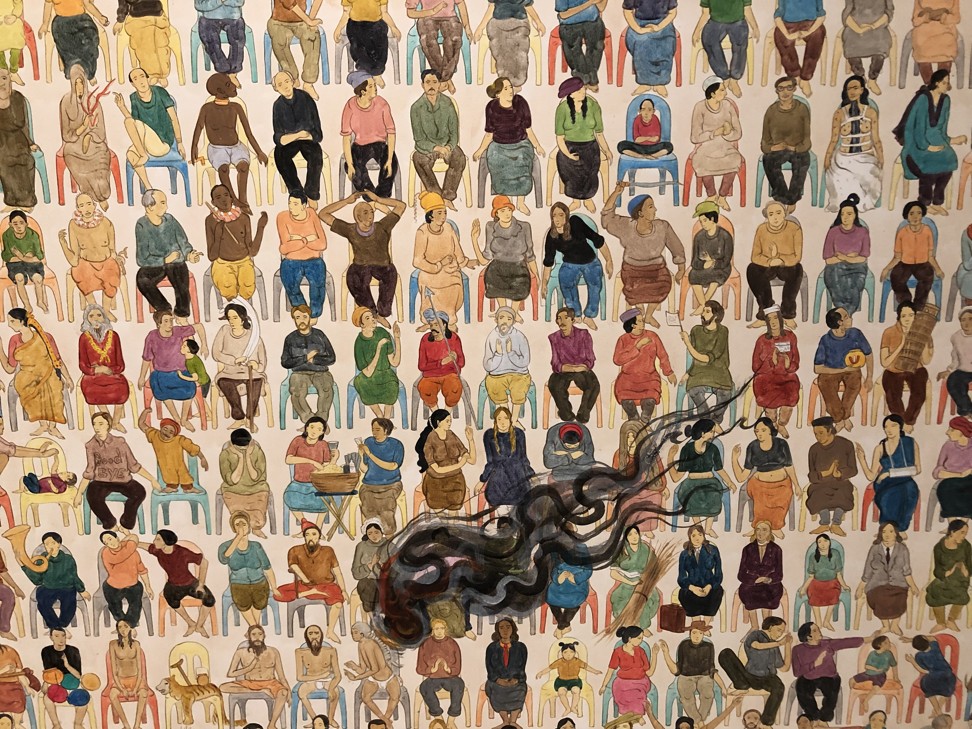
From Gandhi to the UN: Indian artist weaves story of destruction and rebirth in Hong Kong show
- N S Harsha’s stimulating and delightful exhibition at the Centre for Heritage, Arts and Textile includes thought-provoking paintings and fabric sculptures
- One is a painting of a fetus on one of the saris his mother wore when she was pregnant with him
It is fitting that Indian artist N S Harsha’s first major Hong Kong exhibition is held at the Centre for Heritage, Arts and Textile (CHAT), a venue borne out of the adaptive reuse of disused cotton mills.
After all, his work from the last 20 years explores the recurring themes of rebirth, renewal and constant change, and also incorporates the use of fabric.
This stimulating and delightful exhibition presents the diverse work of the 50-year-old from Mysore, who is a painter at heart but whose paintings often appear as part of a mixed-media installation.
One of his earliest works here is called Womb On My Mother’s Sari (1995) – a painting of a fetus on one of the saris the artist’s mother wore when she was pregnant with him. “She wanted to throw it away because she didn’t know what to do with it. So I asked her to give it to me and I painted on it. It must have been one of the first works on fabric that I made,” he recalls.

Harsha says fabric came into his art unconsciously. “I think it began with the painting of figures. I always have to decide what they wear and how the fabric flows as part of the symbolism and social political context of that figure. At some point I started painting directly on fabric which I approach with recent Indian history in mind,” he says.
The first thing visitors will notice at the exhibition are the rows of nearly 200 old-fashioned treadle sewing machines, each with a different flag. Nations (2007-present) is one of his best-known works and includes all the flags of the United Nations member states. The flags look like they are being sewn, but they are actually just painted on one side.
Five women artists celebrated in M+ exhibition Sites Encountered
“I’ve left the other side of the flag empty to ask the question of whether the idea of nationhood is being projecting outward only,” he says.
All the machines are linked together with yarn, symbolising the fact that the UN and its goals would unravel if any one member pulls out, he adds.
Harsha History Rental Service (2008), a comical arrangement about the fluidity of cultural identities, centres around a chair reserved for the exhibition security guard. Two dishevelled rows of clothing, including traditional religious costumes, simple garments representing Mahatma Gandhi’s movement and a western-style business suit, hang from the wall. On the floor sits a small spinning wheel – another Gandhi reference – and the head of Brahma, the four-faced god of fertility.

The immersive Sky Gazers (2010/2019) features a large floor painting of many faces turned skyward, which is reflected on the mirrored ceiling. Harsha suggests that visitors stand in the middle of the room and look up, too. They will see themselves becoming one of the crowd.
There are a number of large paintings filled with many small figures and animals. Indian art history, especially Mughal miniatures, seep into his work just as his parents, friends and former teachers do, he says. He often paints the figures and animals in a grid-like, orderly arrangement but something always disrupts the surface tranquillity.
This is true of Come Give Us A Speech (2008) – a series of panels that show all kinds of people and a few deities sitting in plastic chairs – where plumes of black smoke cover parts of the painting. That work is accompanied by Gathering is Evil (2007), in which the only figure is a large, black skeleton against a background of empty, ghostly chairs.
Macau’s casinos are betting big on art – but why?
Harsha says he started working on Come Give Us A Speech first, and experienced an almost destructive urge “to break up my other gathering”.
He started painting black smoke clouds over the figures as he gave in to a “painter’s urge to make marks” and started work on the other painting, where some of the empty chairs are seen toppled, as if a gathering had been abandoned in a rush, or in anger.
It’s not so much about populism or politics but his belief is the need for constant renewal.
“You need to destroy beliefs constantly to be alive, and be grounded. Otherwise, old ideas become pollutants. Sure, heritage matters but you have to deconstruct what you inherit – like my mother’s sari,” he says.

The way to renew ideas is through other people, and he says he likes to pay tribute to those who influence him by including them in his exhibitions.
For the Hong Kong show, he brought along his friends Juli and Vivek Cariappa, a couple who founded one of India’s first large-scale organic farms near Mysore in 1986 and has become increasingly self-sufficient with help from their two home-schooled sons and small team of helpers.

Apart from food, they grow cotton and dyes such as indigo and work with local communities to produce fabric and clothes. That amounts to a lot of knowledge and experience that can be shared with local organic farmers.
Juli Cariappa says they have conducted a number of workshops in Hong Kong for young farmers, including handing out tips on how to grow indigo after hearing how locals’ attempts have had limited success. They’ve also helped to developed a series of public programmes hosted by local farmers and artists in the CHAT atrium for the duration of Harsha’s exhibition.
N S Harsha: Gathering Delights, Centre for Heritage, Arts and Textile, MILL6 Foundation, The Mills, 45 Pak Tin Par Street, Tsuen Wan, New Territories, Wed-Mon 11am-7pm. Until Nov 3.

